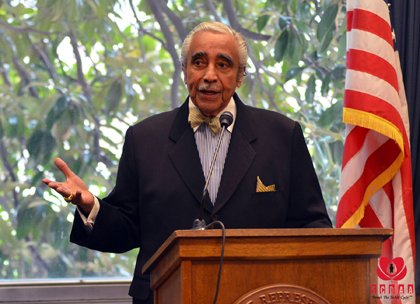The Centers for Disease Control and Prevention (CDC) estimates that Sickle Cell Disease (SCD) affects 90,000 to 100,000 Americans. The disease disproportionately affects African Americans and Hispanic Americans. The CDC notes that SCD occurs in about one out of every 500 African-American births, and in one out of every 36,000 Hispanic-American births.
Courtesy Photo
Sonja L. Banks is president and CEO of the Sickle Cell Disease Association of America, In
To bring more attention to the disease, the Sickle Cell Disease Association of America, Inc. (SCDAA) announced the formation of the first-ever Congressional Caucus for Sickle Cell Disease. Led by Representatives, Charles Rangel (D-NY), Danny Davis (D-IL), and Senator Tim Scott (R-SC), the Caucus is working toward bringing public and congressional awareness to the unique needs and legislative issues of the Sickle Cell Disease community, which includes patients, physicians, and scientists.
The Congressional Caucus for Sickle Cell Disease was also designed to create opportunities that address barriers in access to care and development of crucial research and treatments. On April 3, 2014, which marked National Sickle Cell Advocacy Day, the Caucus hosted its first ever “Capitol Hill Luncheon – Legislative Briefing.” The Legislative briefing was held in the Rayburn House Building in Washington, D.C.
Representatives Rangel, Davis, and Scott led a public briefing to address media questions.
“This was historic for us,” said Sonja L. Banks, president and CEO of SCDAA. “Getting a Caucus is not an easy feat. However, Congressman Rangel really pushed us to get the Caucus. There are not many diseases that have caucuses. However, we have enough members who care enough to focus on the disease. Congressman Rangel actually suggested a caucus, which is good in this political climate.”
A Congressional Caucus is a group of members of the United States Congress that meets to pursue common legislative objectives.
“On the advocacy side, the purpose of this event was to push for new funding and programs and the renewal of the Sickle Cell Act, which has expired,” said Banks. “It has been carried over in the budget, but there are some who are proposing to get it cut.”
She added, “We also wanted to understand the political climate, because programs are being cut because there is no money, etcetera. They helped us to understand the climate of all of that.”
The Sickle Cell Anemia Control Act was first signed into law in 1972 by former President Richard Nixon. Ten million was provided to expand SCD programs in 1972.
SCD affects more than 90,000 patients in the U.S., with the disease disproportionately affecting African-Americans and Hispanic Americans. It is caused by an inherited mutation in the beta-globin gene that makes red blood cells change from their normal shape, which is round and pliable (like a plastic bag filled with corn oil), into a rigid sickle-shaped cell (like a corn flake).
Normal red blood cells are able to pass easily through the tiniest blood vessels, called capillaries, carrying oxygen to organs such as the lungs, liver and kidneys. However, due to their rigid structure, sickled blood cells get stuck in the capillaries and deprive the organs of oxygen, which causes organ dysfunction and failure.
Banks is the newly elected president and CEO of SCDAA, which was created out of a 1971 meeting to pursue the vision of a national coordinated approach to addressing issues related to SCD.
“Our focus must be on treatment as we search for a cure,” said Banks. “I hope we are close to a cure, but the focus for us is treatment. We do not have enough people who know about the disease, and people need to see the reality of this disease. We need to raise more funds for treatment and research. The more we see, hear, and read about SCD, the more attention we can bring to it.”
Banks also talked about some of the treatments for SCD.
“One of the major protocols are new SCD provider guidelines coming through the National Institutes for Health to treat this disease. Hydroxyurea is still out there in terms of treatment, and there are some new drugs, which are showing progress. However, there is an overwhelming shortage of hematologists that focus on sickle cell.”
She added, “In addition, most patients don’t have a medical home or specialist that is monitoring their care. Most live in the emergency room. However, when they go to the emergency room, the costs are astronomical. In addition, once SCD patients get older, there is no transition care.”
According to Banks, a national walk will be held at Lake Montebello on August 30, 2014, and the SCDAA will host a convention October 1 through October 4, 2014 at the Hyatt Inner Harbor Hotel.
For more information visit www.sicklecelldisease.org.

